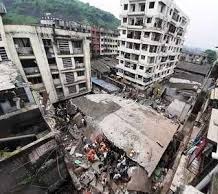The collapse of Jilani building in the powerloom town of Bhiwandi points to the crisis of illegal constructions in the wider Mumbai Metropolitan Region.
Civil engineer and activist Kamankar Durraj alleges 500 illegal buildings have come up in Bhiwandi in the past five years using inferior material or lacking even a designated architect. Jilani building itself did not follow norms and lacked a proper access path for the fire brigade. Locals allege Patel Compound where it is located has another 20 illegal buildings, some of which are recent constructions.
Within Thane district, the Bhiwandi-Ulhasnagar and Mumbra belt is notorious for lack of compliance to building norms. The 2013 collapse of an illegal building in Mumbra, which claimed 74 lives, has been among the worst tragedies here in recent years. Jilani building had been classified as old and the landowner was issued several notices by civic authorities, asking for a structural audit to be conducted. The civic body, though, took no further action over the past three years.
Thane city has witnessed nearly 16 building collapses in the past 25 years in which 175 people have lost their lives. The reasons range from illegal constructions to lack of repair of old and dilapidated buildings.
As many as 4,500 structures in Thane city are classified as dangerous. A pre-monsoon survey by Thane Municipal Corporation revealed that 79 buildings across the nine administrative wards of the city were in an extremely dangerous condition and needed to be pulled down. Around 2,400 were collectively in the C2 category (in need of urgent repairs), of which around 127 needed evacuation and immediate major repairs. The rest were classified as dangerous but with no immediate threats to residents.
Officials and activists in Bhiwandi say cluster redevelopment schemes are the way ahead. “Bhiwandi has several buildings which violate norms or use extra FSI. For redevelopment, cluster development schemes are needed,” says Dr Pankaj Ashiya, commissioner of Bhiwandi-Nizampura City Municipal Corporation. PWD minister Eknath Shinde said the government would try to bring cluster development to Bhiwandi.
In Mumbai city, lack of repair of old and dilapidated buildings is the main reason for collapses. There are around 15,000 cessed buildings in the island city, most of which were constructed before 1969. In the bulk of cases, repairs are stuck because of lack of funds and disputes between landlords and tenants.
In the past three months, the city had seen three building collapses at Dongri, Nagpada and Fort areas, killing eight people.
The state government agency Mhada collects cess from such buildings for their repair. The rules, though, allow it to spend just around Rs 3,000 per square metre for the repair of each building through its life-span, says Amin Patel, Congress MLA from Mumbaidevi. Recently, Maharashtra government passed a bill for time-bound redevelopment of cessed buildings.
Non-cessed buildings in the suburbs, though, are even worse off since they get no help from the government.
“Often tenants are ready to go in for repairs, but landlords are more interested in razing buildings,” says Ramesh Prabhu, president, Maharashtra Societies Welfare Association.
Shirish Sukhatme, former president of the Practising Engineers, Architects and Town Planners Association, said, “In non-cessed buildings, there are also instances where landlordbuilders in connivance with civic officials declare the repairable building dilapidated to force the tenant to vacate.”


